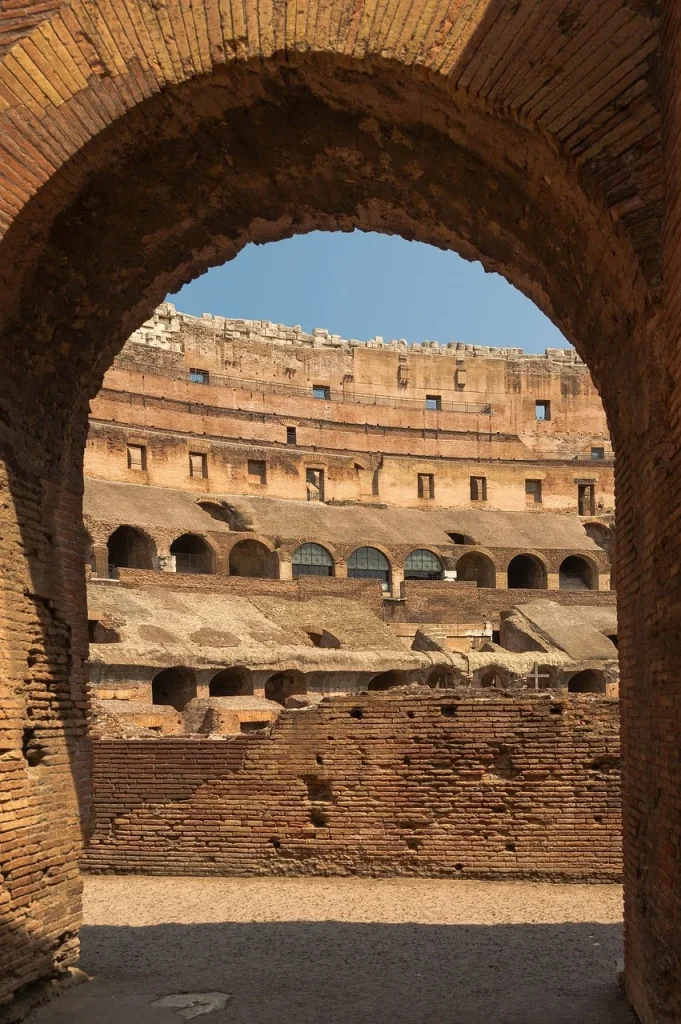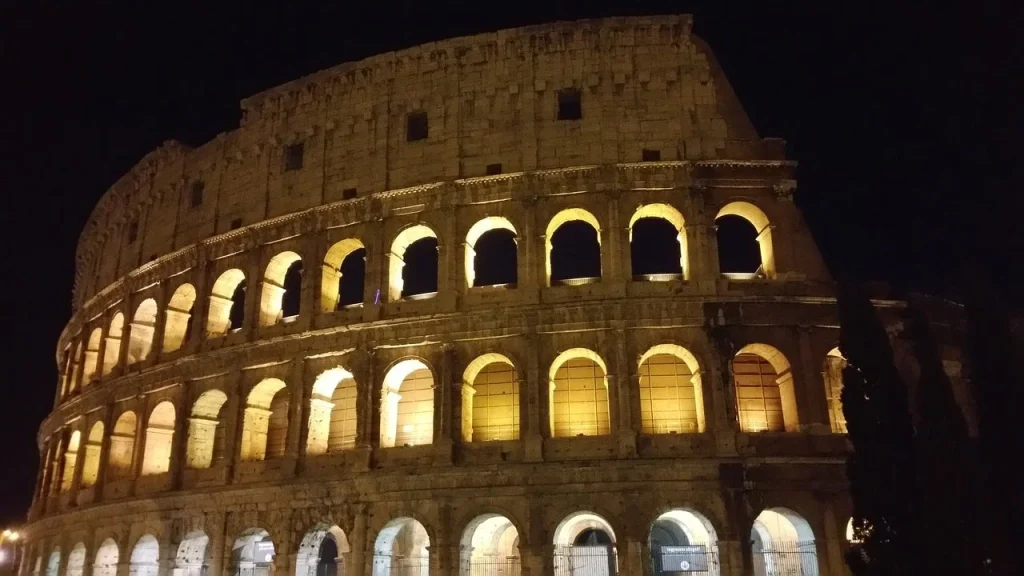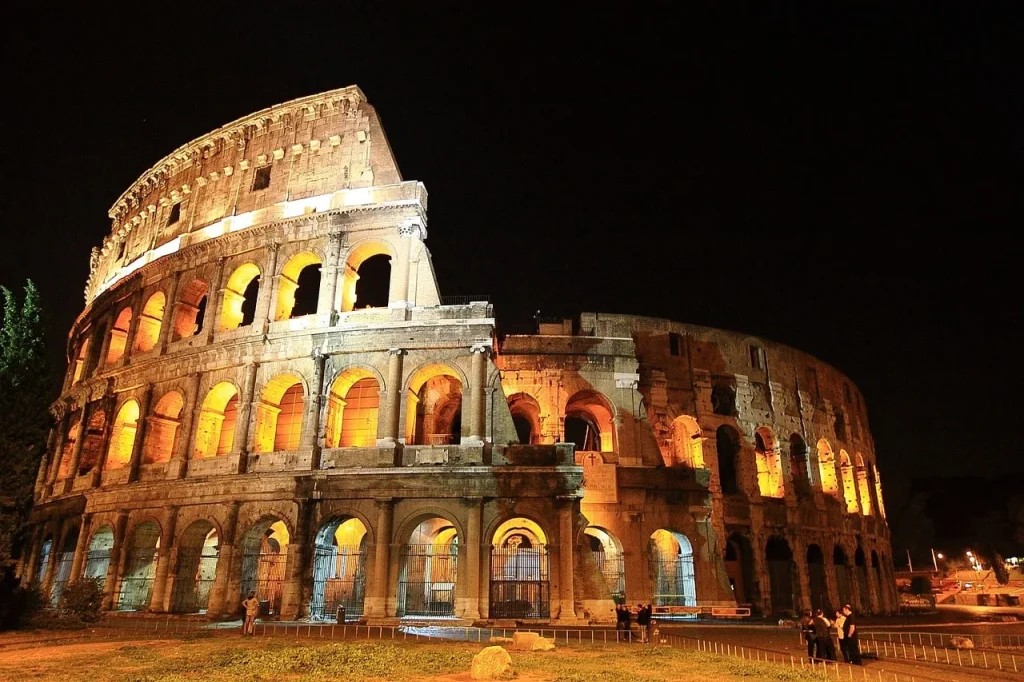What if I told you that the Colosseum holds more secrets than most of us realize? This ancient arena, a masterpiece of Roman architecture, has been the site of legendary battles, a showcase of emperors’ power, and a symbol of resilience against time’s decay.
We’ll uncover some fascinating facts about the Colosseum, from the ingenious methods used in its construction to the wild spectacles that entertained thousands. Join me as we step back in time to explore the history, mysteries, and enduring allure of one of the greatest wonders of the ancient world.
While stands the Colosseum, Rome shall stand; When falls the Colosseum, Rome shall fall; And when Rome falls – the World.
Lord Byron
Colosseum Facts
Let’s dive into the ancient world of the Colosseum. Remember, a quiz awaits at the end of this article, challenging you to prove your expertise on this iconic monument. Read carefully to ace it!
- The edifice was largely financed by treasures seized from the Jewish Temple during the Siege of Jerusalem in 70 CE.
- A capacity exceeding 50,000 showcases the architectural brilliance of the Romans in this amphitheater.
- With 80 distinct entryways, the venue could be evacuated in just a few minutes, demonstrating efficient crowd management.
- Massive canvas coverings, known as vela, shielded the audience from the harsh sun.
- The Hypogeum, a complex network of underground passages, was where beasts and fighters awaited their turn.
- Before the construction of the hypogeum, the arena could be inundated to stage naval skirmishes.
- The myth that many Christians faced martyrdom here is largely debunked by historical evidence.
- Sand coated the ground to soak up blood, showcasing the arena’s grim purpose in a practical manner.
- It has withstood multiple earthquakes, which damaged but did not destroy the monument.
- Dismantled for its materials in later centuries, the structure became a source of building blocks for medieval Rome.
- It wasn’t known as the “Colosseum” until medieval times, a name likely derived from a colossal statue nearby.
- Animals from every corner of the empire, including lions and giraffes, were brought here to fight.
- Gladiator fights were halted in the 5th century by an edict from Emperor Honorius.

- Over time, it has served various purposes, including a graveyard, residential area, and fortress.
- A Christian religious group’s occupation in the 18th century helped preserve it as a holy site.
- Its nighttime illumination acts as a beacon against the death penalty, lighting up after a sentence is commuted or abolished.
- Its elliptical shape, stretching 189 meters long and 156 meters wide, was a feat of ancient engineering.
- Originally named Amphitheatrum Flavium, its construction was initiated by the Flavian dynasty.
- The façade required over 100,000 cubic meters of travertine stone, transported from distant quarries.
- Now, it stands as one of Rome’s most visited landmarks, attracting millions of visitors annually.
- Wealthy Romans would sponsor games, a practice akin to modern-day corporate sponsorship, for political leverage.
- There were exclusive areas for the emperor and Vestal Virgins, providing unparalleled views of the arena floor.
- Despite its bloody history, it is a symbol of Rome’s imperial legacy and architectural prowess.
- A unique ecosystem has formed within its walls, home to various plants and microorganisms.
- Conservation efforts in recent years aim to preserve its integrity for future generations.
- The labyrinth of tunnels beneath the arena featured elevators and pulleys for transporting animals and scenery.
- Its partial ruin still inspires modern stadium designs worldwide, a testament to its enduring architectural influence.
- After the construction of the Hypogeum, the reenactment of naval battles was discontinued.

- The amphitheater’s design influenced the development of modern arenas with its tiered seating and oval shape.
- St. Peter’s Basilica and other Roman monuments were built using materials taken from this ancient structure.
- At night, it becomes a beacon against capital punishment, its illumination marking a stand for humanity.
- Up to a million animals and half a million humans lost their lives in the games hosted here.
- Lightning strikes have caused fires and damage to the monument throughout its storied past.
- During the Renaissance, its ruins were studied by architects as examples of classical Roman engineering.
- Unauthorized digs in the 19th century aimed at unearthing valuables led to further damage.
- The oval design was intended to prevent crowd crushes and ensure clear views for all spectators.
- It now serves as a venue for cultural events, connecting ancient history with contemporary art.
- The inaugural games were a grand affair, lasting 100 days with a mix of combat and spectacle.

- Its history has been romanticized in popular culture, often overshadowing the more complex realities.
- The provision of free entertainment, or “bread and circuses,” aimed to placate the public, is epitomized by the Colosseum’s games.
- Many gladiators were slaves or prisoners, with some volunteering for the chance at glory and reward.
- As an iconic symbol of Rome, it requires constant upkeep and protection against vandalism.
- Environmental and urban pressures continue to threaten its long-term stability.
- A major cleaning and restoration project concluded in 2016, which revived its façade to its former glory.
- It is the backdrop for the Pope’s Good Friday procession, blending its ancient legacy with Christian traditions.
- Its endurance through nearly two millennia underscores Rome’s architectural mastery and historical depth.
- Modern ticketing systems manage the influx of tourists, reminiscent of the ancient strategies for crowd control.
- The Colosseum’s presence on the Roman skyline is a testament to the durability of Roman construction techniques, surviving through centuries of natural and human challenges.
- Its architecture inspired the design of modern sporting venues around the globe, emphasizing the importance of spectator visibility and comfort.
- A symbol of Rome’s legacy, the Colosseum’s image appears on the Italian version of the five-cent euro coin, integrating ancient history with contemporary currency.
Colosseum Myths

Now that we’ve explored the facts about the Colosseum, let’s continue with a different arena: separating truth from myth. There are plenty of stories out there, but which ones hold up?
- Christians Were Regularly Martyred Here
It’s often believed that it was a prime location for the persecution of early Christians. However, historical evidence suggests that this is more of a of a legend than a fact. While Christians were persecuted in ancient Rome, there’s limited evidence directly linking the Colosseum to the widespread martyrdom of Christians. - All Gladiators Were Slaves
The common narrative portrays gladiators as slaves forced into combat. In reality, not all gladiators lived in bondage. Many were free men who volunteered, driven by the lure of fame, glory, or financial reward. Their training was rigorous, and they were valued as skilled athletes. - The Colosseum Could Be Flooded for Naval Battles
While the Romans did stage such spectacles, evidence suggests they occurred in other venues. The engineering required to flood the Colosseum is debated by historians, indicating it might not have been feasible. - Animals Fought in the Arena Until Extinction
While thousands of animals were indeed killed, this practice did not directly lead to the extinction of any species. The decline of some species was due to broader factors like habitat loss and overhunting across their range, not just arena games. - The Colosseum’s Destruction Was Caused by Barbarian Invasions
In truth, the structure was damaged by natural disasters, such as earthquakes, and the stones were later repurposed for building projects. The narrative of barbarians sacking Rome contributes to this myth, but the Colosseum’s decline was a more gradual process, influenced by both human and environmental factors.
No products found.
Colosseum Quotes

Let’s explore its enduring legacy through the words of those who witnessed its grandeur, from emperors to chroniclers. Feel free to share yours in the comments so I can add them to the list as well.
The Colosseum is the last sight in Europe that can astound an American.
Ralph Waldo Emerson
Ralph Waldo Emerson’s reflection on the Colosseum’s grandiosity suggests it surpasses the wonders of the New World in its historical and architectural majesty.
Rome is the city of echoes, the city of illusions, and the city of yearning; the Colosseum embodies them all.
Giotto di Bondone
An artistic perspective by Giotto di Bondone, encapsulating the Colosseum as a monumental embodiment of Rome’s deep historical layers and its power to evoke longing and reflection.
The Colosseum might be partially ruined, but its history and presence still reign intact.
Stendhal
Stendhal emphasizes the enduring legacy and the majestic presence of the Colosseum, despite the physical damage it has sustained over centuries.
To see the Colosseum is to see the strength and foundation not just of Rome, but of all modern civilization.
Henry James
Henry James points out the foundational role of the Colosseum in the cultural and historical development of Western civilization, highlighting its importance beyond just Rome.
The sun setting behind the Colosseum is Rome’s greatest spectacle; one that captures the essence of ancient glory.
Margaret Fuller
Margaret Fuller captures the picturesque and timeless beauty of the Colosseum at sunset, symbolizing the enduring allure of Rome’s ancient grandeur.
Colosseum FAQ

Before you face the challenge of the quiz, we have one more important stop: the FAQ section. These common questions will help you score a perfect ten.
- Why is the Colosseum a wonder of the world?
It is celebrated for its architectural innovation and scale, symbolizing the Roman Empire’s grandeur. Its ability to captivate millions with its history and sheer size solidifies its status as a global wonder. - Will the Colosseum be used again?
It now hosts cultural and educational events, focusing on preservation rather than its ancient functions, serving as a historical symbol rather than a venue for spectacles. - How has the Colosseum changed over the years?
Affected by time, natural disasters, and looting, it has lost many original features. However, ongoing restoration efforts aim to preserve its iconic stature and historical significance. - Who created the Colosseum?
Emperor Vespasian commissioned it, and his son Titus completed it, marking it as a Flavian dynasty achievement, meant to entertain and showcase Roman architectural skills. - Can you visit the underground tunnels of the Colosseum?
Yes, the hypogeum, or underground chambers, are open for guided tours, providing a look into the preparation areas for gladiators and animals before their battles.
No products found.
Colosseum Trivia

Welcome to our Colosseum quiz! Remember, if you don’t get any questions right, you might find yourself facing the lions tomorrow morning—just kidding, we left them back in Ancient Rome!
Conclusion
As our exploration comes to a close, it’s clear that this ancient arena is not just a relic of the past but a living lesson in history, culture, and human ambition. Its walls have witnessed the breadth of human emotion, from triumph to tragedy, reflecting the complexity of the society that built it.
The Colosseum serves as a poignant reminder of what humanity can achieve when it dares to dream big. It challenges us to build our legacies and inspire future generations just as it has inspired us. Till next time, stay curious and explore more. Cheers.
1 Source Used For This Article

